CRUISE CONTROL
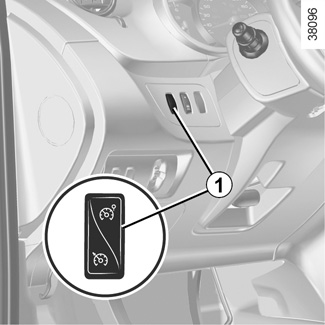
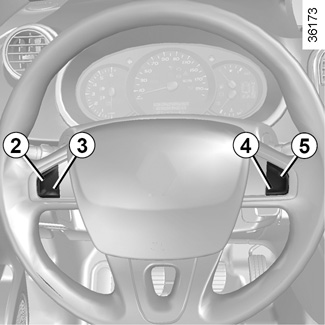
The cruise control function helps you to maintain your driving speed at a speed that you choose, called the cruising speed.
This cruising speed may be set at any speed above 20 mph (30 km/h).
Controls
1 Main “On/Off” switch.
2 Cruising speed activation, storage and increase switch (+).
3 Decreasing cruising speed (-).
4 Switch the function to standby (with cruising speed saved) (O).
5 Activation with recall of saved cruising speed (R).
The cruise control function is in no way linked to the braking system.
This function is an additional driving aid. The function does not take the place of the driver.
Therefore, it can under no circumstances replace the driver’s responsibility to respect speed limits and to be vigilant (the driver must always be ready to brake).
Cruise control must not be used in heavy traffic, on undulating or slippery roads (black ice, aquaplaning, gravel) and during bad weather (fog, rain, side winds etc.).
There is a risk of accidents.
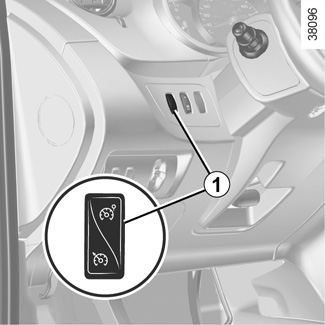
Switching on
Press switch 1 on the side showing .
Indicator light 6 comes on, lit green, and the message “CRUISE CONTROL” appears on the instrument panel, accompanied by dashes to indicate that the cruise control function is activated and waiting to store a cruising speed.
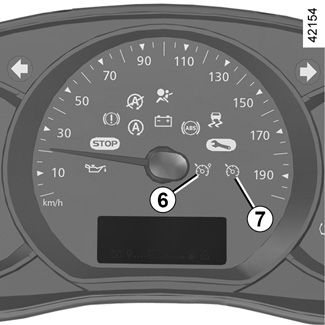
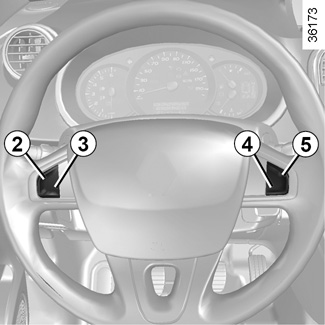
Activating cruise control
At a steady speed (above 18 mph (30 km/h approximately)) press switch 2 or (+): the function is activated and the current speed is saved.
The cruising speed replaces the dashes and the cruise control is confirmed by the appearance of a message on the instrument panel and indicator light 7 lit green, as well as indicator light 6.
Driving
Once a cruising speed is memorised and the cruise control function is active, you may lift your foot off the accelerator pedal.
Please note that you must keep your feet close to the pedals in order to react in an emergency.
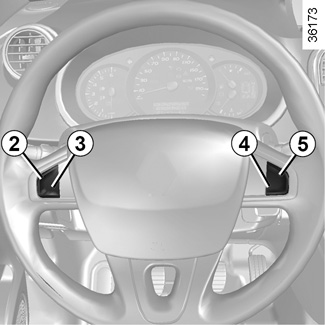
Adjusting the cruising speed
The cruising speed may be changed by pressing the following repeatedly:
- switch 2 (+) to increase the speed,
- switch 3 (-) to decrease the speed.
Exceeding the cruising speed
The cruising speed may be exceeded at any time by depressing the accelerator pedal. While it is being exceeded, the cruising speed flashes on the instrument panel.
Then, release the accelerator: after a few seconds, the vehicle will automatically return to its set cruising speed.
Cruising speed cannot be maintained
When driving down a steep gradient, the system is unable to maintain the cruising speed: the stored speed will flash on the instrument panel information display to inform you of this situation.
The cruise control function is in no way linked to the braking system.
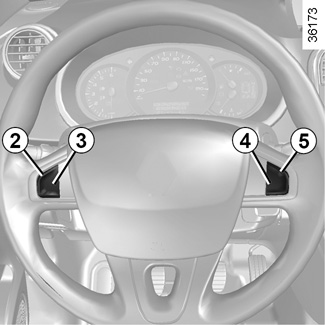
Putting the function on standby
The function is set to standby if you:
- the brake pedal;
- depress the clutch pedal or shift into neutral if the vehicle has an automatic gearbox;
- press switch 4 (O).
In all three cases, the cruising speed is stored.
Standby is confirmed when the green warning light goes out and the “SPEED MEMORY” message appears on the instrument panel.
Recalling the cruising speed
If a speed has been stored, it is possible to recall it by pressing button 5 (R), on condition that you are driving faster than 20 mph (30 km/h) and that you are sure that the road conditions are suitable (traffic, road surface condition, weather conditions, etc.).
Note: if the speed previously stored is much higher than the current speed, the vehicle will accelerate more rapidly to reach this threshold.
When the cruise control is on standby, pressing the (+) buttons 2 reactivates the cruise control function without taking into account the stored speed: it is the speed at which the vehicle is moving that is taken into account.
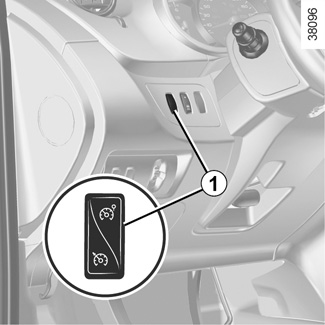
Switching off the function
The cruise control function is deactivated if you press switch 1: in this case a speed is no longer stored.
The green and indicator lights on the instrument panel go out, confirming that the function is deactivated.
Putting the cruise control on standby or switching it off does not cause a rapid reduction in speed: you must brake by depressing the brake pedal.